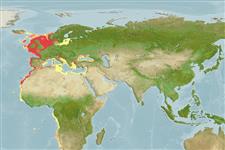Common names from other countries
Environment: milieu / climate zone / depth range / distribution range
Ecologia
marinhas demersal; intervalo de profundidade 5 - 450 m (Ref. 35388), usually 10 - 40 m (Ref. 4710). Subtropical; 66°N - 21°N, 28°W - 41°E
Eastern Atlantic: Iceland and Scotland southward, also North Sea, Kattegat and Baltic; Mediterranean Sea: including Adriatic, Sea of Marmara, Bosporus.
Length at first maturity / Tamanho / Peso / Idade
Maturity: Lm 7.9, range 7 - 8 cm
Max length : 20.0 cm TL macho/indeterminado; (Ref. 88088); common length : 8.0 cm TL macho/indeterminado; (Ref. 3397); peso máx. Publicado: 53.28 g (Ref. 88088); Idade máx. registada: 13 anos (Ref. 32766)
Espinhos dorsais (total) : 0; Raios dorsais moles (total) : 65 - 78; Raios anais moles: 49 - 63. Anterior nostril on blind side not enlarged, anterior nostril on eyed side with a backward-pointing tube, reaching to vertical through front margin of lower eye. Pectoral fins on blind side reduced to a single long and 1-2 short fin rays. The supra-temporal branch of lateral lie without tubular scales. Vertebrae 36-38. Scales rectangular, intercanalicular striae strongly curved.
Demersal on sandy bottoms of continental shelf and slope. Feeds on a wide range of bottom-living organisms, mainly crustaceans (copepods, amphipods, cumaceans), bivalve mollusks, and polychaetes (Ref. 3397).
Bauchot, M.-L., 1987. Poissons osseux. p. 891-1421. In W. Fischer, M.L. Bauchot and M. Schneider (eds.) Fiches FAO d'identification pour les besoins de la pêche. (rev. 1). Méditerranée et mer Noire. Zone de pêche 37. Vol. II. Commission des Communautés Européennes and FAO, Rome. (Ref. 3397)
Categoria na Lista Vermelha da IUCN (Ref. 130435)
CITES (Ref. 128078)
Not Evaluated
Ameaça para o homem
Harmless
Utilização humana
Pescarias: pouco comercial
Ferramentas
Relatórios especiais
Descarregue XML
Fontes da internet
Estimates based on models
Preferred temperature (Ref.
115969): 8.1 - 18.8, mean 10.6 (based on 734 cells).
Phylogenetic diversity index (Ref.
82804): PD
50 = 1.0000 [Uniqueness, from 0.5 = low to 2.0 = high].
Bayesian length-weight: a=0.00851 (0.00716 - 0.01011), b=3.05 (3.00 - 3.10), in cm Total Length, based on LWR estimates for this species (Ref.
93245).
Nível Trófico (Ref.
69278): 3.3 ±0.4 se; based on diet studies.
Resiliência (Ref.
120179): Médio, tempo mínimo de duplicação da população 1,4 - 4,4 anos (K=0.54-0.61; tm=3; tmax=13).
Fishing Vulnerability (Ref.
59153): Low vulnerability (24 of 100).
